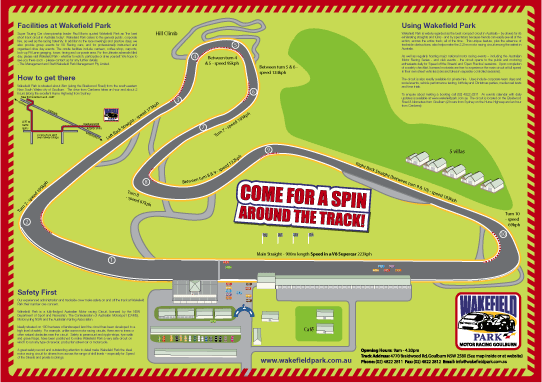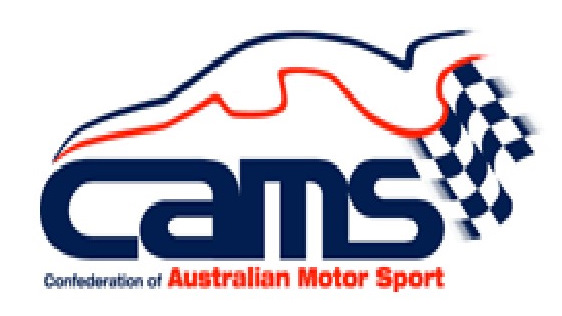DON'T Race on the Road!
Marulan Driver Training Centre
is dedicated to road safety through driver training and education. They offer training and facilities of the highest standard, from the specially designed driver training facility, to their classrooms and training aids.
As part of Marulan Driver Training Centre's education regime they hold regular Track Days for those who want to take their street cars and learn their own and their cars potential under controlled conditions with tuition available if required.
Futhermore they also hold Bike Ride Days which allows riders to take their own street bike and ride them under controlled conditions with tuition also available if required. 
Speed Off the Streets
Drive your Car on a Real Race Track
If you ever wanted to driver your car fast, then Wakefield Park is the place to go. Its simple and fun and you make your self a better driver each and every time.
Wakefield Park now offers its Speed off the Street Days, where road-registered street cars can run on the circuit for a small fee. Drivers can learn how their vehicle can really perform, in order to better understand how to control their vehicle on the road.
Just take yourself and your street car and for just $120 per day (week days) you can experience what it’s like to Drive around a race track. Australian Autosport Alliance licence required $50.00 (annually)
Drivers need to wear appropriate attire.
• Approved road use helmet (also available for hire at track)
• Neck-to-wrist-to-ankle clothing protection (could be long sleeve shirt and long pants)
• Closed in shoes (cover ankle to toe)
* Helmet hire available for $20 per day with a $50 Deposit
Everyone has fun on speed off the street days no matter what car your driving.


Grassroots Motor Sport
Traditional club-level events offer both beginners and juniors a terrific starting point to learn about car control and are low in cost and risk, but high in excitient. With an inexpensive CAMS licence and your everyday road car, almost anyone can compete in these types of events.
In Speed events, vehicles travel in a forward direction from a standing start along a track or course with drivers aiming for the fastest time over a specified distance.
In Non-Speed events, there are factors other than the fastest time which determines the overall result.
Anyone can compete in these events provided they have the appropriate CAMS competition licence. Both Level 2S (Speed) and Level 2NS (Non-Speed) licences can usually be purchased at the event and there is no formal driver training required unless specified by the club or event organiser. Junior licences are also available and a civil driving licence may be required in some cases.
Refer to the CAMS website for minimum age restrictions.
Circuit Racing
Circuit racing is any form of four-wheel motor racing that takes place on a closed racing circuit. Each state in Australia has at least one permanent racing circuit and some also have temporary street circuits. There are many levels of circuit racing ranging from club and state level, which are purely amateur, to national and international championships which are contested by professional racing teams and drivers.
In circuit racing, all drivers compete for the fastest lap times during a qualifying session prior to the race which determines each car’s starting position on the grid. Each car then battles to cross the finishing line first after the required number of laps.
Who can compete?
Anyone can compete in circuit racing. Most people start off by competing in events such as sprints and hillclimbs before graduating to circuit racing. Drivers must successfully complete a licence lecture, observed licence test and medical examination before obtaining their licence. A junior licence is also available for Superkart competitors.
Refer to the CAMS website for minimum age restrictions.
Which cars can compete?
There are many different classes of cars that can compete in circuit racing events. Below are some examples:
-
Open Wheelers (e.g. Formula Vee, Formula Ford, Formula 3)
-
Sports Cars - open and closed (e.g. Ferrari, Lotus, RX7, MG, Porsche, MR2, Supersports Cars)
-
Touring Cars (e.g. V8 Supercars, Sports Sedans, Improved Production Cars, HQ Holdens, Saloon Cars)
-
Superkarts (Gearbox & Non-Gearbox, 80cc up to 250cc)
Rally
Rallying is one of the more team-oriented forms of motor sport enabling both driver and navigator to work together and experience the thrill of competition.
Rallies are traditionally run on unsealed roads and can range from novice non-special stage trials run at club and state level, through to Australian and World Rally Championship events. Tarmac rallying is also an expanding form of the sport.
Some rallies can be navigational events where the emphasis is placed on map reading and the speeds are not necessarily high, or route-charted events where navigators are provided with a road book which contains the information required to complete a special stage or road section.
Who can compete?
Anyone can compete in rallying. Most people start off by competing in autocross events before moving on to introductory or novice clublevel rallies to gain further experience, and then graduate to state-level events which are more competitive. Competitors in tarmac rally events often obtain experience in speed events or circuit racing.
In most events, drivers require a current civil driving licence and must successfully complete a licence lecture and an observed licence test. Navigators only need to complete the lecture. A junior licence is also available for drivers and navigators.
Refer to the CAMS website for minimum age restrictions.
What cars can compete?
People competing in introductory events can use their everyday road car, whereas more specialised cars are required to compete in higher level events. Whilst many people competing in state and national championships have upgraded to four-wheel-drive rally cars such as Subaru WRXs and Mitsubishi Lancers, many people continue to compete with older style cars, including Datsuns, Escorts, and early Commodores, which run in separate classes.
Historic Motor Sport
Historics is a rapidly growing discipline of motor sport where people with all types of historic vehicles can get involved. Principles of authenticity, preservation and amateur competition ensure that historic motor sport is non-aggressive and iphasis is placed on sportsmanship, enjoyment and the social aspects of motor sport.
Historics encompass almost every discipline of motor sport.
To find out more about historic motor sport, visit
www.cams.com.au/sport/historics
Who can compete?
Anyone with an interest in good competition and the historic side of motor sport can get involved. The principal thing that you will need is an acceptable historic car. You will also need the appropriate CAMS competition licence.
What cars can compete?
Most historic groups require a car to have a competition history in the relevant historic era, whilst for other groups this is not required. There are many classes in the various disciplines of historic motor sport with cars ranging in age from pre-1931 right up until cars built in the late 1980s and early 90s.
Formula Vee
Formula Vee
is recognised as Australia's entry level motorsport category. Competition is close like V8 SuperCars and Formula One.
Formula Ford
Formula Ford
is the world's premier junior development category in motor sport. Currently, over 70% of the 2009 V8 Supercar field, raced in the Formula Ford category in their early careers, as did many Australian stars racing overseas, including Formula One driver Mark Webber.
An open wheeled racing car, Formula Fords comply with stringent rules designed to reduce costs for newcomers to the sport, and to allow every driver to compete on his or her own merits.
Every Formula Ford is constructed from a light-weight tubular space frame designed to maintain the highest levels of driver safety. Aerodynamic modifications, such as wings and spoilers, are prohibited.
Each vehicle is powered by this 'control' Ford Fiesta 1600cc, 100ps DOHC, lightweight aluminum, four cylinder engine. Tuned to develop more than 125 horsepower, Formula Fords reach speeds in excess of 250 km/h.
Saloon Car Racing
The Australian
Saloon Car
Series is an initiation to the traditional Ford v Holden rivalry.
This entry level formula encourages door handle to door handle racing in a friendly, cost effective and social environment. The national Series is based around seven events held across Australia as a part of the Shannons National Motor Racing Championships, with a number of states and territories also conducting hotly contested local competitions.
See what’s out there
Attending different types of motor sport events will help you work out which discipline of the sport you would like to become involved in. Motor sport events are run on almost every weekend of the year in each state, ranging from grass roots events like club-level hillclimbs and motorkhanas, to international events like Rally Australia and the FORMULA 1™ Australian Grand Prix.
Competition Licence Forms
